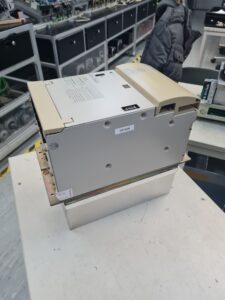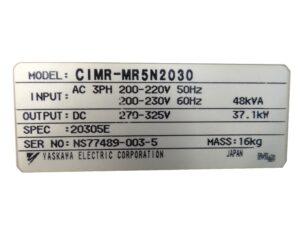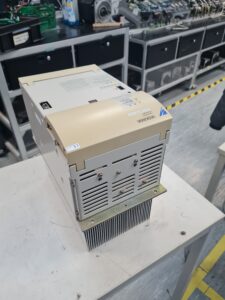20.06.2025 by Viktor Siebert
Repair Report: Yaskawa CIMR-MR5N2030 – When High Performance Fails to Ignite
Emergency from the Production Line
A long-standing customer contacted us due to a complete machine failure: The Yaskawa VS-656 MR5 Converter, model CIMR-MR5N2030, had stopped a CNC machine entirely. Error messages such as AL.01 (Overcurrent) and AL.44 (Heatsink Overheat 2) pointed to severe internal damage. With no replacement device available on short notice, the customer opted for an express repair with us.
Incoming Inspection: What We Check First
As soon as the unit arrived, we carried out a comprehensive visual inspection, looking for common signs of damage:
- Swollen or discolored capacitors
- Burn marks or blown semiconductors
- Thermal damage near the heatsink
- Internal contamination from oil mist or dust (common in production-heavy environments)
Before powering up the unit, we connected it to our custom isolated diagnostic system that supplies regulated voltage. This allows us to detect shorts or leakage currents at low power, preventing further internal destruction.
Detailed Repair Process
- Disassembly & Cleaning:
- Full disassembly of all subassemblies
- Intensive cleaning using anti-static ultrasonic bath
- Controlled drying in a convection oven
- Electronic Diagnosis & Component Replacement:
- Replacement of damaged IGBT modules
- Testing and, if necessary, replacement of the DC-Link capacitor bank
- Installation of new NTC resistors for thermal regulation
- Exchange of gate drivers if trigger signals are unstable
- Installation of new heatsink thermistors
- Replacement of the internal fan, even if only slightly aged
- Control Board Diagnostics:
- PCB tested with oscilloscope and signal generator
- Replacement of EEPROM chip (critical for F0/F1 faults)
- Re-soldering of high-current paths using leaded solder for longevity
- Mechanical Servicing:
- Cleaning and inspection of the heatsink
- New thermal interface pads
- Checking of power rail spring contacts
Functional Testing & Quality Assurance
Before releasing the unit, we put it through a strict 3-stage testing process:
- Insulation & High Voltage Testing:
- According to DIN EN 61557
- Minimum insulation: >100 MΩ at 500 VDC
- Load Testing on Original Setup:
- Coupled with a genuine VS-626M5 Inverter
- Simulated load cycles with real motor load
- Voltage, current ripple, and thermal performance monitored
- Burn-In Stress Test:
- 8-hour continuous run under rated load
- Live monitoring via oscilloscope and digital sensors
- Watch for thermal drift, instability, or random failures
🧾 Final Report & Return to Customer
A detailed repair report is generated for each unit, including measured values and serial number tracking. A service label is attached showing the repair date, technician code, and tracking number for full traceability
Conclusion
This repair of the Yaskawa CIMR-MR5N2030 once again demonstrates how precision diagnostics and the replacement of key components can bring industrial hardware back to life—even after complex failures. Our structured test and inspection protocol ensures full reliability—often exceeding the original factory performance.



Further information such as price and delivery time for:
Yaskawa Converter VS-656 MR5 CIMR-MR5N2030 Spec. 20305E
More details about our Yaskawa repair expertise can be found here: Yaskawa Reparatur bei Industrypart
📞 Please feel free to contact us if you have any questions regarding your Omron drive technology. Our experienced team is always available to assist you.
Technical Specifications – Yaskawa CIMR-MR5N2030
| Parameter | Value |
|---|
| Model | CIMR-MR5N2030 |
| Specification Number | 20305E |
| Input Voltage | 3-phase AC 200–220 V @ 50 Hz / 200–230 V @ 60 Hz |
| Input Capacity | 48 kVA |
| Output Voltage (DC) | 270–325 V |
| Output Power | 37.1 kW |
| Weight | 16 kg |
| Cooling Type | External heatsink with forced air (panel-mounted installation) |
Operating Environment & Integration
- Application: Designed for CNC machinery, machining centers, lathes, transfer systems, and test benches.
- Installation Conditions:
- Ambient Temperature: 0–55 °C (inlet air < 45 °C)
- Humidity: 5–95%, no condensation
- Environment: Indoor only, free from corrosive gases, oil mist, and dust
- System Integration:
- Works in combination with Yaskawa VS-626M5 Inverter
- Compatible with YENET1200 communication interface
- Supports multi-axis systems with regenerative power feedback
Functional Overview
The CIMR-MR5N2030 is a power regenerative converter designed to convert 3-phase AC input into a stable DC bus voltage. Its key functions:
- Supplies DC power to inverters and servo amplifiers in multi-axis machine setups
- Supports continuous regenerative braking during deceleration
- Equipped with IGBT-based switching for fast and precise response
- Allows energy feedback into the grid, improving energy efficiency
- Enables high-speed CNC operations with minimal thermal drift
Alarm Codes & Troubleshooting (Excerpt from Converter Manual)
| Alarm Code | Fault Description | Recommended Action |
|---|
| Overcurrent | Output current exceeds detection level | Check wiring, power supply, load rating |
| Main Fuse Blown | Main circuit fuse failed | Check for short circuits or damaged IGBT module |
| Overload | Load current exceeded rated threshold | Reduce load, check inverter/servo size |
| Output Overvoltage | DC output > 400 V (200V class) | Verify input voltage, system design |
| Undervoltage | DC output dropped below threshold | Check input voltage |
| Control UV | Control power supply voltage too low | Verify control input supply |
| Servo Power Fault | Servo unit voltage abnormal | Check control wiring |
| Frequency Fault | Input frequency deviates > ±5% | Check input waveform and supply quality |
| Initial Charging | DC capacitors not charged within timeout | Replace unit |
| Open Phase | Missing input phase | Check phase sequence and connections |
| Heatsink Overheat 1 | Heatsink temperature exceeded warning limit | Improve cooling, check ambient temperature |
| Heatsink Overheat 2 | Critical overheat sustained | Improve ventilation, clean heatsink |
| PCB Temp Fault | PCB temperature over 80–85 °C | Improve cooling, check fan operation |
| Thermistor Fault | Thermistor disconnected or failed | Replace thermistor or control board |
| EEPROM / ROM Error | Memory or CPU fault | Replace controller board |